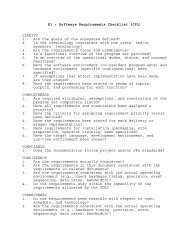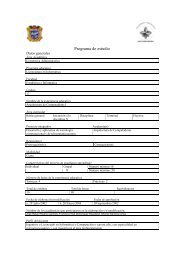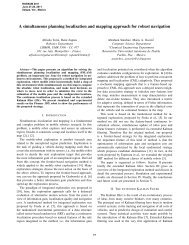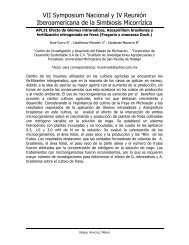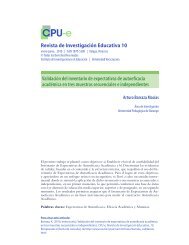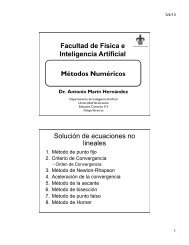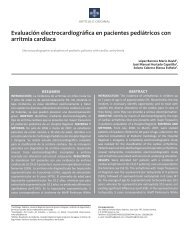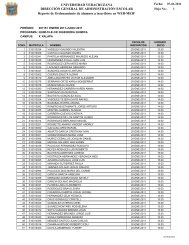Suplemento 2 Vol 8 No 1.indd - Universidad Veracruzana
Suplemento 2 Vol 8 No 1.indd - Universidad Veracruzana
Suplemento 2 Vol 8 No 1.indd - Universidad Veracruzana
You also want an ePaper? Increase the reach of your titles
YUMPU automatically turns print PDFs into web optimized ePapers that Google loves.
Evidence from the developmental and memory<br />
literatures suggests that local sleep is use-dependent. Thus<br />
a plethora of experimental interventions ranging from<br />
whisker stimulation in rats to unilateral somatosensory<br />
stimulation, arm immobilization, adroit learning paradigms<br />
in humans 1 , and selective sensory deprivation of neonates<br />
32,33 indicate that localized changes in sleep EEG delta power<br />
or blood flow 34 are enhanced if during prior waking the<br />
areas were disproportionately activated relative to other<br />
brain areas. Such findings support the idea that sleep is not<br />
only local in nature, but also that its expression is related to<br />
prior brain activity—i.e., that it is use-dependent.<br />
Sleep can be independently expressed in units of<br />
brain as small as cortical columns. This may be the minimal<br />
component in brain capable of sleep 35 . Cortical columns<br />
are densely interconnected assemblies of neurons thought<br />
to be the basic unit of information processing. In these rat<br />
experiments, individual cortical columns (whisker barrels)<br />
exhibit responses called evoked response potentials that are a<br />
measure of input/output relationships. The evoked response<br />
potentials are greater during sleep than during wakefulness.<br />
Individual columns can show the characteristic responses<br />
during sleep while neighboring columns exhibit wakelike<br />
responses. Vice versa, individual cortical columns<br />
can display wake-like states while neighboring columns<br />
show sleep-like responses when the rat is functionally and<br />
behaviorally asleep. These data suggest a degree of cortical<br />
column local state autonomy although local column state<br />
usually corresponded with whole animal state. The local<br />
sleep state occurs more frequently when the cortical column<br />
at hand is stimulated more intensively thereby exhibiting<br />
a use-dependency of state. These results point to cortical<br />
columns as the basic unit of brain circuitry involved in<br />
sleep and sleep regulation. Finally, if TNF is applied locally<br />
to the cortex it enhances the amplitudes of evoked response<br />
potentials suggesting that it induces the local sleep-like<br />
states in cortical columns 36 .<br />
Cortical column state has an impact on overt<br />
behavior in rats 37 . In an experimental learning paradigm<br />
dependent upon sensory stimulation of a single whisker,<br />
when the corresponding whisker barrel was in the wakelike<br />
state, correct behavioral responses to whisker twitching<br />
were elicited. However, when the whisker barrel was in<br />
50<br />
Revista Médica<br />
the sleep-like state, the rat made errors. In the prevailing<br />
top-down paradigm of sleep regulation, intentional action<br />
from the specialized sleep/wake regulatory brain circuits<br />
is required to initiate and terminate whole-organism sleep,<br />
raising unresolved questions as to how that purposeful action<br />
might itself be initiated. The new paradigm of local, usedependent<br />
sleep regulation avoids such infinite regresses.<br />
It posits instead that local sleep is a direct consequence of<br />
prior local use and that whole-organism sleep is essentially<br />
a bottom-up, self-organizing, emergent property of the<br />
collective states of cortical columns throughout the brain<br />
26 . In our theory, a role remains for specialized brain nuclei<br />
and pathways involved in whole-organism sleep regulation,<br />
e.g. coordination of cortical columns to synchronize into<br />
single whole-brain vigilance states and coordination of<br />
overall brain states with other physiological systems in the<br />
body including nitch-adapted circadian rhythms. However,<br />
sleep initiation resides in the individual cortical columns<br />
and other neural assemblies across the brain.<br />
Implications for sleep function<br />
The sleep regulatory mechanism presented results in<br />
the stabilization of cell sensitivity by changing receptor<br />
populations for inhibitory (adenosine) and excitatory<br />
(glutamate) molecules. This action occurs as a consequence<br />
of neuronal activity and is thus localized to the sites<br />
where activity-induced changes in synaptic efficacy and<br />
connectivity are occurring. Thus, SRSs, altered by activity, in<br />
turn alter expression of the receptors involved in plasticity. A<br />
comprehensive understanding of the molecular and genetic<br />
mechanisms of sleep remains incomplete. Nevertheless,<br />
our view of sleep mechanisms clearly link sleep and neural<br />
connectivity.<br />
Our proposed sleep mechanism also provides insight<br />
into unconsciousness. We assume that within neuronal<br />
assemblies input during waking induces environmentally<br />
adaptive outputs. With prolonged activation of networks<br />
within the assemblies (excessive input) the mechanisms<br />
shown in Figures 1 and 2 and Table 2 would be activated<br />
and the consequent SRS release would induce a new output<br />
in response to the same input. The new output would likely<br />
be irrelevant to the environmentally-driven input. It would<br />
be maladaptive if allowed to manifest in cognitive or motor<br />
Revista Médica de la <strong>Universidad</strong> <strong>Veracruzana</strong> / <strong>Suplemento</strong> 2 <strong>Vol</strong>. 8 núm. 1, Enero - Junio 2008



